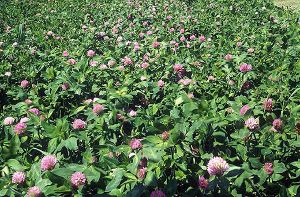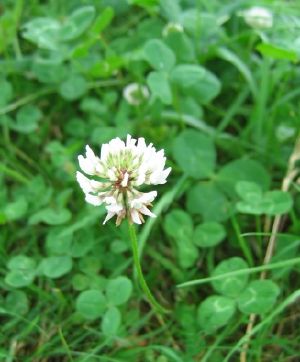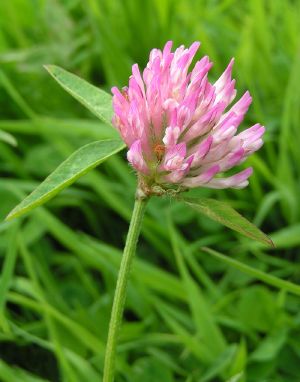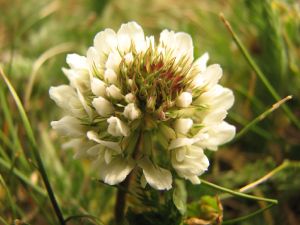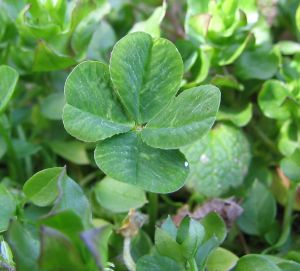Clover
| Clover | ||||||||||||||||
|---|---|---|---|---|---|---|---|---|---|---|---|---|---|---|---|---|
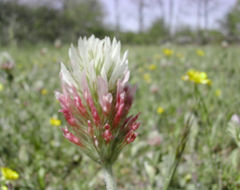 clover inflorescence
| ||||||||||||||||
| Scientific classification | ||||||||||||||||
| ||||||||||||||||
|
See text |
Clover (Trifolium), or trefoil, is a genus of about 300 species of plants in the pea family Fabaceae. The genus has a cosmopolitan distribution; the highest diversity is found in the temperate Northern Hemisphere, but many species also occur in South America and Africa, including at high altitudes on mountains in the tropics.
They are small annual, biennial, or short-lived perennial herbaceous plants. The leaves are trifoliate (rarely 5- or 7-foliate), with stipules adnate to the leaf-stalk, and heads or dense spikes of small red, purple, white, or yellow flowers; the small, few-seeded pods are enclosed in the calyx.
Other closely related genera often called clovers include Melilotus (sweet clover) and Medicago (alfalfa or 'calvary clover'). The "shamrock" of popular iconography is sometimes considered to be young clover.
The scientific name derives from the Latin tres, "three", and folium, "leaf", so called from the characteristic form of the leaf, which has three leaflets (trifoliate); hence the popular name trefoil. Clovers are used as food plants by the larvae of some Lepidoptera (butterfly and moth) species; see list of Lepidoptera that feed on clovers.
Selected Species
|
|
|
Cultivation
Several species are extensively cultivated as fodder-plants. The most widely cultivated clovers are White clover Trifolium repens and Red clover Trifolium pratense. Clover, either sown alone or in mixture with ryegrass, has for a long time formed a staple crop for soiling, for several reasons: it grows freely, shooting up again after repeated mowings; it produces an abundant crop; it is palatable to and nutritious for livestock; it grows in a great range of soils and climates; and it is appropriate for either pasturage or green composting.
In many areas, particularly on acidic soil, clover is short-lived because of a combination of insect pests, diseases and nutrient balance; this is known as "clover sickness". When crop rotations are managed so that clover does not recur at shorter intervals than eight years, it grows with much of its pristine vigour.
Clover sickness in more recent times may also be linked to pollinator decline; clovers are most efficiently pollinated by bumblebees, which have declined as a result of agricultural intensification. Honeybees can also pollinate clover, and beekeepers are often in heavy demand from farmers with clover pastures. Farmers enjoy the benefits of increased reseeding that occurs with increased bee activity, which means that future clover yields remain abundant. Beekeepers benefit from the clover bloom as clover is one of the main nectar sources for honeybees.
T. repens, White or Dutch clover, is a perennial abundant in meadows and good pastures. The flowers are white or pinkish, becoming brown and deflexed as the corolla fades. T. hybridum, Alsike or Swedish clover, is a perennial which was introduced early in the 19th century and has now become naturalized in Britain. The flowers are white or rosy, and resemble those of the last species. T. medium, meadow or zigzag clover, a perennial with straggling flexuous stems and rose-purple flowers, is of little agricultural value.
Other British species are: T. arvense, Hare's-foot trefoil; found in fields and dry pastures, a soft hairy plant with minute white or pale pink flowers and feathery sepals; T. fragiferum, Strawberry clover, with densely-flowered, globose, rose-purple heads and swollen calyxes; T. procumbens, Hop trefoil, on dry pastures and roadsides, the heads of pale yellow flowers suggesting miniature hops; and the somewhat similar T. minus, common in pastures and roadsides, with smaller heads and small yellow flowers turning dark brown. The last named is often called Shamrock.
Clovers are a valuable survival food, as they are high in protein, widespread, and abundant. They are not easy to digest raw, but this can be easily fixed by juicing them or boiling them for 5-10 minutes. Dried flowerheads and seedpods can also be ground up into a nutritious flour and mixed with other foods. Dried flowerheads can also be steeped in hot water for a healthy, tasty tea
Symbolism and mythology
Shamrock, the traditional Irish symbol coined by Saint Patrick for the Holy Trinity, is commonly associated with clover, though also sometimes with Oxalis species, which are also trifoliate (i.e. they have three leaves).
Clovers occasionally have leaves with four leaflets, instead of the usual three. These four-leaf clovers, like other rarities, are considered lucky.
A common idiom is "to be in clover", meaning to be living a carefree life of ease, comfort, or prosperity.
The cloverleaf interchange is named for the resemblance to the leaves of a (four-leafed) clover when viewed from the air.
ReferencesISBN links support NWE through referral fees
- This article incorporates text from the Encyclopædia Britannica Eleventh Edition, a publication now in the public domain.
- Quattrofolium
- McGraw-Hill. 2005. McGraw-Hill Concise Encyclopedia of Science & Technology, 5th edition. 2005. New York: McGraw-Hill.
0071429573
Credits
New World Encyclopedia writers and editors rewrote and completed the Wikipedia article in accordance with New World Encyclopedia standards. This article abides by terms of the Creative Commons CC-by-sa 3.0 License (CC-by-sa), which may be used and disseminated with proper attribution. Credit is due under the terms of this license that can reference both the New World Encyclopedia contributors and the selfless volunteer contributors of the Wikimedia Foundation. To cite this article click here for a list of acceptable citing formats.The history of earlier contributions by wikipedians is accessible to researchers here:
The history of this article since it was imported to New World Encyclopedia:
Note: Some restrictions may apply to use of individual images which are separately licensed.
